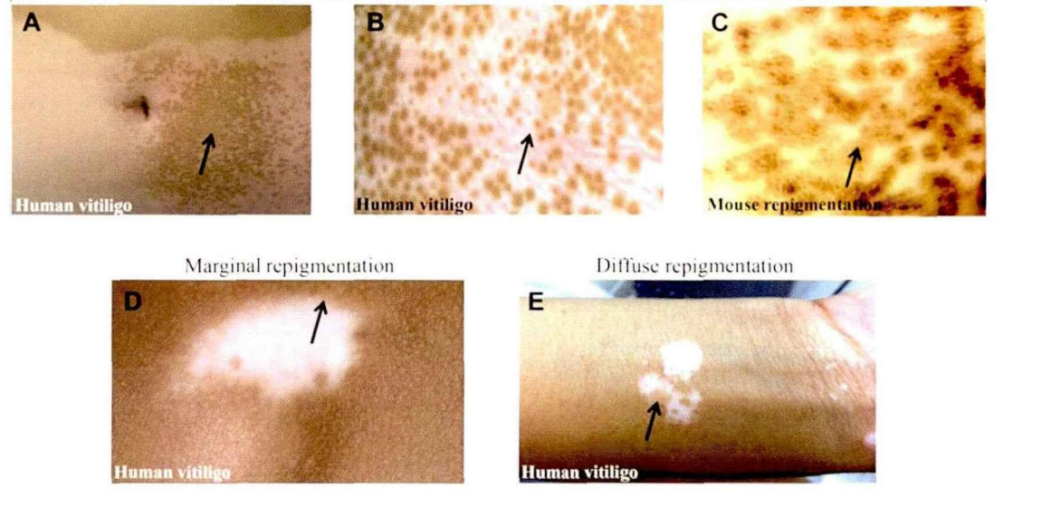
In the course of treatment of vitiligo, the response degree and speed of different parts of the white spot to the treatment are significantly different. Some special parts such as: mucosa and thin and tender parts, hands and feet and white-haired areas have poor treatment response, and are prone to long-term treatment and difficult to cure. In the clinic, these special parts of the white spot is often classified as "refractory vitiligo", with a long course of treatment, slow effect characteristics, very affect the life of patients.
In recent years, with the deepening of the research on the treatment of vitiligo, the treatment of "refractory vitiligo" has also made some new progress.
First, why is refractory white spot difficult to treat?
As we all know, the complexing of vitiligo is inseparable from melanocytes, which are important cells for the production and transport of melanin. It can be said that whether the skin is black or not depends on the number of melanocytes and the sound degree of cell function. The occurrence of vitiligo means that the melanocytes in the skin are missing or their function is impaired, making the skin unable to produce melanin normally.
Therefore, the idea of vitiligo color treatment can be simply summarized as "find a way to repair and supplement sound melanocytes, so that the white spot color."The root cause of the difficulty in treating refractory vitiligo is that the pathway to replenish melanocytes is blocked, especially when the melanocyte reservoir (such as the melanocyte stem cells in the hair follicle) is damaged.
Hair follicle polychromatic pattern is a common polychromatic pattern in vitiligo. Hair follicles contain melanocyte reservoirs (melanocyte stem cells) that differentiate into melanocytes that continuously supply melanin to the skin and hair [1]. After treatment, the color pattern usually first appears around the hair follicle. At first, the mouth of the hair follicle produces sporadic pigment spots, and then the pigment islands gradually expand and fuse, eventually covering the entire decolorized area.
Hair grows in hair follicles and gets its color from melanin. When gray hair appears in the skin lesion, it often means that the hair follicle melanocytes and their reservoirs in the area have been damaged, resulting in insufficient melanin production, which in turn triggers hair bleaching. There is no follow-up melanocyte supplement source, indicating that the later treatment of white hair area lesions is more difficult.
In addition, some parts such as fingers, toes, palms and mucous membranes, due to the small distribution of hair follicles, melanocyte reservoirs are relatively scarce, which makes the treatment of vitiligo in these areas more complicated, and the recolor effect is often poor. At the same time, the intractable parts of the limbs, such as hands and feet, also have slow blood circulation and metabolism, which cannot reach the blood drug concentration required for treatment, resulting in poor efficacy and a long treatment cycle.
Therefore, promoting peripheral melanocyte migration or surgical transplantation has become a popular choice for refractory vitiligo.
Second, treatment options for refractory leukoplakiaUltraviolet phototherapy can effectively promote the proliferation and differentiation of melanocyte stem cells. It is suitable for the treatment of progressive and stable vitiligo. It is one of the strongest and safest means to induce white spot recolor at present. Therefore, active use of phototherapy for multilateral combined treatment or become a new idea for the treatment of refractory vitiligo.
1. Intractable vitiligo of hands and feetDue to the convenience and safety of treatment, phototherapy combined with topical drug therapy is recommended as the first choice for the treatment of difficult parts of the extremities and joints. Due to the thick stratum corneum of the extremity, topical drugs are usually difficult to penetrate. Therefore, on the basis of phototherapy, selecting a variety of ways to accelerate the introduction of drugs is the mainstream choice for the treatment of vitiligo of the extremity and joint.
Ultraviolet phototherapy combined with CO2 laser and hormone therapy can effectively improve the discoloration of hands and feet. An observation on the efficacy of ultraviolet phototherapy combined with CO2 dot matrix laser and halamethasone cream in the treatment of vitiligo of hands and feet showed [2] that after 20 weeks of treatment, the effective rate of the treatment of advanced hands and feet reached 58.2%, and the effective rate of stable treatment reached 83.3%. The overall treatment is effective and encouraging.
The treatment of hands and feet is difficult, and when phototherapy and its combination therapy are ineffective, patients can consider surgical transplantation. It should be noted that surgical transplantation is only supported in patients with stable stage, and patients with advanced stage should be cautious.